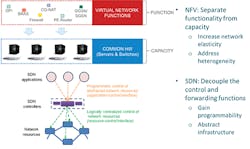Latest from Home
Interoperability has become a key focus as the multiple organizations involved in NFV look ahead to 2018.
The virtualization of network functions offers multiple benefits, allowing services to be launched quickly while ensuring the efficient use of networks. But there are several barriers to be overcome before network functions virtualization (NFV) can reach its full potential.
The industry knows it is facing a major challenge. Indeed, NFV requires a complete overhaul of proprietary hardware-based networks to focus on software. This raises issues spanning the technical through to the cultural.
But despite this complexity, progress is being made in agreeing standards and specifications around NFV. Thanks to the efforts of all the participants in the ETSI NFV Industry Specification Group (ISG), we have seen the specifications in Release 2, and are heading to Release 3. At the same time, proof of concept projects are evolving, with a number of interoperability tests taking place across the globe.
Even so, there is still more work to be done. One of the key issues when dealing with next-generation virtualized networks is the integration of the network functions, and the network services created by composing them, with independently developed management and orchestration systems.
In order to tackle the issue, it is important to ensure an open ecosystem that will facilitate innovation from a range of new (and existing) players. That is why, during 2017, the NFV ISG introduced unified API specifications aiming to make multi-vendor interoperability possible at the same time accelerating the roll out of NFV.*
The idea is, this will lead to interoperable solutions and network services from a variety of different vendors.
The API standard sits alongside the release of specifications covering the packaging structure for the distribution of virtualized network function (VNF); the definition of metrics for monitoring the supporting infrastructure; the application of acceleration resource management; and a complete revision of the use cases that were defined at the start of the NFV initiative. In addition, 18 new work items have been approved, related to service provision, security and privacy enhancements, network slicing, and new formats for describing functions and services.
The Next Steps
Fuelled by innovation and the move towards 5G, the momentum behind NFV standards and specifications is set to continue. Over the next year, work is being done on Release 3, which will provide specifications and advice for making NFV technologies fully operational.
Release 3 will also help improve and enrich the framework we have provided in the concrete specifications and make it easier for NFV deployment and operation globally. As part of this, we have started to examine how best to apply NFV to network slicing.
Meanwhile, as cyberattacks become more complex and sophisticated, there is also a focus on ensuring that solutions are secure by design. Taking this into account, NFV security is of paramount importance to the ISG, and therefore will become even more significant in the coming year.
Another area of focus is automation — which is, of course, a key part of NFV. In this area we have to address the reduction of complexity, analyzing how to automate different service management tasks at the same time as orchestrating the life cycle of the network functions.
But the ability to automate also offers huge potential: once the issues are ironed out, there are multiple possibilities for what can be achieved by automating many other tasks for end-to-end service delivery.
At the same time, with the recently defined standards covering APIs available from the end of 2017, it will be in 2018 that we will witness a vast improvement of NFV. This will hopefully translate into an even more open ecosystem and an increasing number of companies innovating in the NFV environment.
NFV Plugtests
As part of the progress made during 2017, the first round of ETSI Plugtests® events helped us to address issues including the pain points for mixing and matching the different NFV functionalities and capabilities.
So, following the initial successful NFV Plugtests, the second round will build on this further. To be held in Sophia Antipolis, France, between 15 and 19 January, the upcoming event will see representatives from vendors and open source communities evaluate their implementations’ level of interoperability and confirm they adhere to the NFV specifications defined by ETSI.**
The 5-day interoperability session will deal with all key components of NFV deployments, including VNFs, NFV infrastructure, virtual infrastructure managers, and management and orchestration solutions. Supporting open source communities include ETSI Open Source MANO (OSM), OPNFV, and OpenStack.
Other areas to be examined include multi-site operation, network path, enhanced platform awareness, fault and performance management, and NFV APIs.
The event will also demonstrate the importance of a continuous and ubiquitous testing environment. This will see remote integration and pre-testing for the event, as well as further collaborative testing and validation activities.
Working Together
NFV has the potential to revolutionize networks. To achieve this, ETSI collaborates with other groups from the ecosystem.
ETSI is also collaborating with open source groups including OPNFV, OpenStack, and the newly started ONAP initiative on system level integration, deployment, and testing.
It can be seen that much progress was made in 2017, and this momentum is set to continue into the coming year as industry and standards groups start to resolve the issues around NFV. But it is important to accept that no one group can do this alone. It is only by working together that we will achieve the best specifications and solutions to drive NFV forward.
Endnotes
*"ETSI adds extra dimensions to virtualization of communication networks with continued NFV specification activity" by Sophia Antipolis, 3 October 2017. ETSI. http://www.etsi.org/news-events/news/1220-2017-10-news-etsi-adds-extra-dimensions-to-virtualization-of-communication-networks-with-continued-nfv-specification-activity
**"ETSI hosted a second in its series of NFV Plugtests events" by Sophia Antipolis, 6 September 2017, ETSI. http://www.etsi.org/news-events/news/1215-201709-news-etsi-set-to-host-second-in-its-series-of-nfv-plugtests-events






